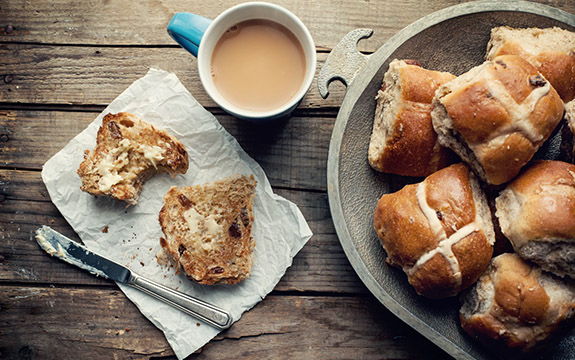Indulging at Easter

In Summary
- The Swinburne dietetics and nutrition team share their advice for indulging at during Easter break
Easter is often seen as a time to relax and indulge, but it can be difficult to know exactly when to stop. Swinburne’s nutrition and dietetics experts have compiled some tips and advice to help you enjoy a happier Easter.
When it comes to chocolate, what’s the difference?
The experts break it down like this:
- Milk chocolate is made of cocoa powder, cocoa butter, with milk and sugar added
- Dark chocolate has a much higher cocoa content than milk (30 to 85 per cent cocoa), it has less sugar and it does not have milk solids added
- White chocolate contains more sugar than milk and dark, and it contains cocoa butter but no cocoa powder
Is chocolate good for you?
The cocoa in chocolate contains flavanols, which are antioxidants that can benefit cardiovascular health. As dark chocolate has a much higher cocoa content, it contains more flavanols than milk chocolate.
“Studies have shown consumption of dark chocolate to be associated with cardiovascular measures such as lower blood pressure, improved blood vessel function and better insulin function,” says nutrition and dietetics lecturer Leah Dowling.
“Chocolate is also thought to promote the release of the ‘happy hormone’ serotonin, enhancing the enjoyment of eating it.”
Ms Dowling adds that there are many other foods that can yield similar health benefits. Apples, grapes, red wine and tea are also good sources of flavanols.
How much chocolate should I eat?
“One row or approximately 25-30g of chocolate three times a week is considered a healthy amount,” says Ms Dowling. “The darker the better”.
Depending on the type of chocolate you choose, this will contribute 550kj or 130 calories to your diet, which is the equivalent of about two apples (minus the fibre).
Don’t stress about enjoying your food
With all the treats on offer, many people feel guilty about over-indulging at Easter, but nutrition and dietetics lecturer Carrie Wong says not to worry, as long as you pick your day, and don’t stretch the overindulging into a week or two, your waistline should be OK.
“Pick your day, and give yourself permission to eat,” says Ms Wong.
“This may seem a bit unusual, but it is related to the psychology of eating behaviour. The more restrictions we place on ourselves around eating, the more likely we are to binge and overeat.”
This freedom paves the way for a healthy relationship with food. She says that many people are surprised that when they start saying that they ‘can’ have something, they are able to better regulate how much they have.
Do you really feel like it?
Ms Wong goes on to explain that there are many reasons that people eat, and hunger is not always one of them. It could be related to social pressure, sensory stimulus or habit.
“Try thinking about whether you feel like eating that hot cross bun or Easter egg, or whether it is related to non-hunger reasons,” she says.
“If you genuinely feel hungry for the food, by all means, eat it and enjoy. If, however you’re not really hungry, why not wait a little while until you feel like it?”
Just enjoy it
If you do decide to enjoy that treat “enjoy every mouthful,” says Ms Wong.
“We often forget nowadays why we eat, and we also forget that food also ought to be enjoyed. What this means is to pay attention to what it looks like, its smell as well as its taste. This requires us to eat slowly, concentrate on the food and use our senses to pick up the different properties of food.
She explains that the more attention we pay to food, the more likely we are to enjoy it and feel satisfied. This in turn often means we don’t need as much of the food to feel satisfied.
So make a conscious choice of what you’d really like to indulge in this Easter and enjoy in moderation!
A healthy option
For those looking to have a healthier Easter, why not try making these high fibre choc hazelnut bliss balls, which contain dark chocolate as well as dietary fibre from grains, fruit and nuts to treat your gut as well as your tastebuds.
View this post on Instagram
Recipe and image via @theguthealthdoctor
Ingredients (makes 10, delivering 2.5g fibre per ball)
- 6 Medjool dates, stones remove
- 1/2 cup hazelnuts*
- 2 Ryvita rye breads crushed into small crumb (for a nut-free option, you can swap the hazelnuts for another rye bread)
- 1/4 cup cocoa/ cacao powder
- 6 squares of 70% dark chocolate
Method
- Put the dates in boiling water for a few minutes to soften
- Keep 10 hazelnuts aside and blend the remaining hazelnuts, dates, cocoa powder until smooth (add a splash of milk if it’s too thick)
- Stir half of the crushed Ryvita crumbs into the mixture
- Roll the mixture into 10 balls with a hazelnut in the middle
- Melt the chocolate in the microwave and dip in half of each ball
- Dip half of each ball in chocolate and sprinkle some Ryvita crumbs on top
- Enjoy over Easter or refrigerate for later

